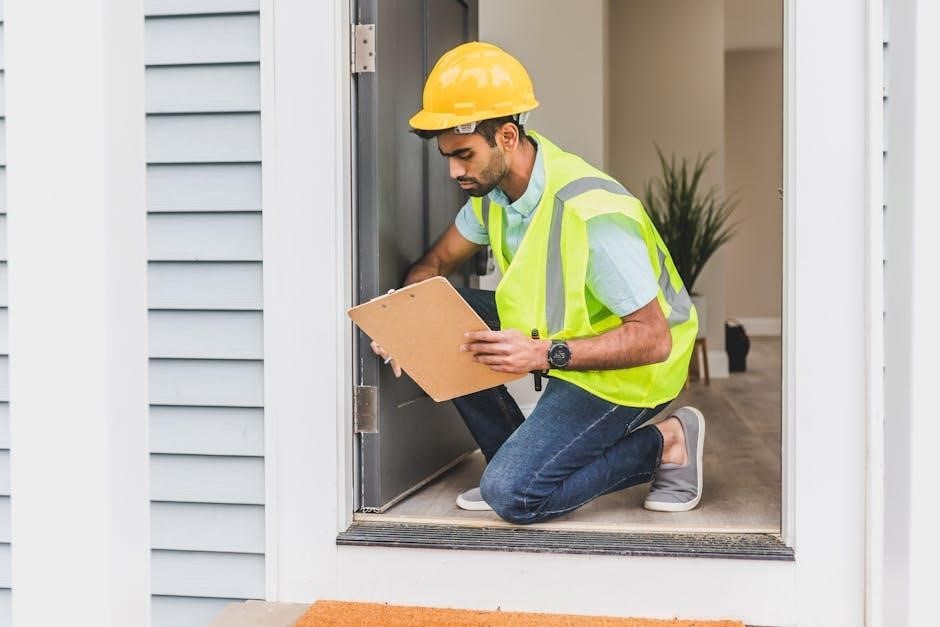A mobile home inspection checklist is a crucial tool for ensuring safety, compliance, and proper maintenance. It helps identify potential issues before they escalate, providing a clear roadmap for evaluations.

Exterior Inspection
The exterior inspection evaluates the condition of walls, siding, roof, windows, doors, skirting, and trim. It ensures structural integrity and identifies weather-related damage or maintenance needs.
2.1 Walls and Siding
The inspection of walls and siding ensures structural integrity and identifies damage or deterioration. Check for cracks, dents, or gaps in the exterior walls and siding panels. Verify that all panels are securely fastened and properly aligned. Look for signs of water damage, rot, or pest infestation. Ensure that exterior fasteners are tight and that no panels are loose or missing. Inspect for any sagging or uneven areas, which may indicate structural issues. Use a mobile home inspection checklist to document findings, ensuring compliance with HUD standards and local building codes. Addressing these issues early prevents costly repairs.
2.2 Roof Condition
Inspecting the roof condition is vital for ensuring the structural integrity of a mobile home. Check for leaks, damaged or missing shingles, and signs of wear around vents and edges. Ensure all roof fasteners are secure and that no gaps exist between the roof and walls. Verify that flashing is properly sealed and that gutters are clear and functioning. Look for sagging or uneven areas, which may indicate structural issues. Use a mobile home inspection checklist to document findings, ensuring compliance with HUD standards and safety regulations. Addressing roof issues early prevents water damage and maintains the home’s value.
2.3 Windows and Doors
Inspecting windows and doors is essential for ensuring energy efficiency and structural integrity. Check for proper sealing, functionality, and signs of damage or rot. Verify that all windows open and close smoothly and that doors align correctly with their frames. Look for air leaks, cracks, or gaps that could compromise insulation. Ensure hardware like hinges and locks is in good condition. Use a mobile home inspection checklist to document any issues, such as worn-out weatherstripping or broken panes. Addressing these problems early can prevent further damage and maintain the home’s overall condition. Properly functioning windows and doors are vital for safety and comfort.
2.4 Skirting and Trim
Inspecting the skirting and trim is vital to ensure the mobile home’s structural integrity and weatherproofing. Check for damage, dents, or gaps in the skirting that could allow pests or moisture to enter. Verify that the skirting is securely attached to the home and evenly installed. Look for signs of rot or wear on the trim around windows, doors, and corners. Ensure all edges are sealed properly to prevent air leaks. A mobile home inspection checklist should include evaluating the condition of skirting and trim, as these elements protect the home from environmental damage and maintain its appearance. Addressing issues promptly can prevent costly repairs.
Interior Inspection
An interior inspection ensures the mobile home is safe, functional, and well-maintained. Check floors, walls, and ceilings for damage or wear. Verify doors and windows open smoothly.
3.1 Floors and Ceilings
During the interior inspection, examine floors and ceilings for damage, wear, or water stains. Check for sagging, unevenness, or soft spots, which may indicate structural issues. Ensure all flooring materials are securely fastened and free from cracks. Inspect ceiling tiles or panels for damage or signs of leaks. Verify that all surfaces are stable, with no evidence of rot or pest infestation. Use a mobile home inspection checklist to document findings, ensuring no detail is overlooked. This step is crucial for maintaining the home’s structural integrity and occupant safety.
3.2 Walls and Doors
Inspect the walls and doors for proper alignment, damage, or signs of wear. Check for cracks, dents, or water damage that may compromise structural integrity. Ensure all doors open and close smoothly, with no sagging or misalignment. Verify that door frames are secure and free from rot or damage. Look for any gaps between walls and doors that could indicate settling issues. Use a mobile home inspection checklist to document findings, ensuring all components meet safety and regulatory standards. This step helps identify potential issues early, preventing costly repairs later. Properly functioning doors and sturdy walls are essential for energy efficiency and security.
3.3 Kitchen and Bathrooms
The kitchen and bathrooms are critical areas to inspect for functionality and safety. Check appliances for proper installation and operation. Inspect plumbing under sinks and around fixtures for leaks or water damage. Test water pressure and ensure all faucets function correctly. Verify that ventilation systems, such as range hoods and exhaust fans, are working efficiently. Examine tiles, countertops, and caulking for cracks or deterioration. Ensure GFCI outlets are installed and functional near water sources. A thorough mobile home inspection checklist helps identify issues early, preventing costly repairs and ensuring a safe living environment. Pay attention to any signs of mold or mildew in these high-moisture areas.

Plumbing System
The plumbing system inspection ensures proper water supply and waste management. Check for leaks under sinks, around fixtures, and in water heaters. Test water pressure and ensure all faucets function correctly. Verify that drain traps and vents are installed properly. Inspect sewer connections for integrity and ensure compliance with safety standards. A thorough evaluation prevents costly repairs and maintains hygiene.
4.1 Water Supply
The water supply system in a mobile home must be thoroughly inspected to ensure functionality and safety. Check all water supply lines for leaks, damage, or corrosion. Verify that connections to sinks, toilets, and appliances are secure. Inspect water heaters for proper installation, temperature settings, and signs of wear; Test water pressure to ensure it is within safe and functional levels. Ensure shut-off valves are accessible and functioning correctly. Also, check for proper installation of water filters or softeners if present. Compliance with local plumbing codes and safety standards is essential to prevent water-related issues.
4.2 Waste Management
The waste management system in a mobile home must be inspected for proper function and safety. Check all sewage connections to ensure they are secure and free from leaks. Verify that vent pipes are clear and properly installed to prevent blockages. Inspect the septic system or hookup for any signs of damage or malfunction. Ensure that all traps and drains are functioning correctly. Look for any signs of backups or water damage. Compliance with local plumbing codes and environmental regulations is crucial to avoid health hazards and legal issues. Proper maintenance ensures the system operates efficiently and safely.

Electrical System
The electrical system inspection ensures all components function safely and efficiently. Check wiring, outlets, and circuit breakers for damage or wear. Verify GFCI protection is present.
5.1 Wiring and Outlets
Inspecting the wiring and outlets is critical for ensuring electrical safety. Check for frayed or damaged wires, loose connections, and outdated systems. Verify that all outlets are functional and grounded. GFCI protection is essential in areas like kitchens and bathrooms to prevent shocks. Look for any signs of overheating, such as discoloration or burning smells. Ensure all electrical components meet current safety standards. DIY inspections can identify obvious issues, but a licensed electrician should evaluate complex problems. Proper wiring and outlet condition are vital for preventing fires and ensuring reliable power distribution throughout the mobile home.
5.2 Circuit Breakers
The circuit breakers are a key component of the electrical system, ensuring power distribution and safety. During inspection, locate the main electrical panel and verify all breakers are labeled correctly. Check for tripped or worn-out breakers and test their functionality. Look for signs of overheating, such as discoloration or burning odors. Ensure the main disconnect works properly and that the panel is securely fastened. Verify that all connections are tight and free from corrosion. Check for any unauthorized modifications or DIY repairs. Properly functioning circuit breakers are essential for preventing electrical hazards and ensuring reliable power supply throughout the mobile home. Regular inspections help maintain safety and efficiency.

HVAC System
The HVAC system in a mobile home is essential for maintaining a comfortable living environment. Inspect the furnace, ductwork, and vents for leaks or damage. Ensure the thermostat functions correctly and all vents are unobstructed. Check for proper insulation in ducts and connections. Verify that the system heats and cools evenly across the home. Look for signs of wear or rust on components. Ensure filters are clean and replace them if necessary. Proper airflow and system performance are crucial for energy efficiency and indoor air quality. Annual professional inspections are recommended to maintain optimal functionality and prevent potential issues.

Foundation and Anchoring
The foundation and anchoring system of a mobile home ensures stability and safety. Inspect the tie-downs for tightness and corrosion, and verify that they meet local building codes. Check the piers for levelness and structural integrity. Look for any signs of shifting or uneven settling. Ensure the skirting is securely attached and free from damage. Proper anchoring prevents movement during high winds or earthquakes. Test the anchors for functionality and verify they are correctly spaced. Any damage or looseness in the foundation system can lead to serious structural issues. Professional inspections are recommended to ensure compliance and safety standards.
Safety Features
Ensure all smoke detectors and carbon monoxide detectors are functional and properly installed; Verify the presence and accessibility of fire extinguishers. Check emergency exits for clear paths.
8.1 Smoke Detectors
Ensure all smoke detectors are installed correctly and functioning properly. Test each detector to confirm they emit a clear alarm sound. Replace batteries annually or as needed. Check for proper placement in bedrooms, hallways, and kitchens. Verify that detectors are less than 10 years old and free from dust or damage. Use the mobile home inspection checklist to document findings. Ensure compliance with local fire safety regulations. Replace any non-working detectors immediately. Keep records of inspections and maintenance for future reference. A functioning smoke detector is crucial for early fire detection and resident safety.
8.2 Carbon Monoxide Detectors
Ensure all carbon monoxide detectors are installed in accordance with local regulations, typically near sleeping areas and fuel-fired appliances. Test each detector using the test button and verify the alarm sounds clearly. Check the power source, whether battery-operated or hardwired, and ensure proper functionality. Replace batteries annually or as specified by the manufacturer. Detectors should be replaced every 5-7 years or when they fail testing. Use the mobile home inspection checklist to document the condition and functionality of each device. Ensure compliance with safety standards to prevent potential carbon monoxide hazards.
8.3 Fire Extinguishers
Ensure all fire extinguishers are easily accessible, properly mounted, and visible in high-risk areas like kitchens and near exit points. Verify the correct type of extinguisher (e.g., multi-purpose ABC) is present for various fire hazards. Check the pressure gauge to confirm it is within the safe operating range and inspect for any signs of damage or tampering. Annual inspections by a certified professional are required, with results documented on the extinguisher’s inspection tag. Use the mobile home inspection checklist to ensure compliance with local fire safety codes and maintain readiness in case of emergencies.
8.4 Emergency Exits
Ensure all emergency exits in the mobile home are unobstructed, functioning properly, and clearly visible. Verify that windows and doors designated as emergency exits open smoothly and are free from damage. Proper lighting for exit routes must be installed and operational. Check that exit signs are visible and comply with local regulations. Ensure at least two accessible exit points are available from every sleeping area. Inspect for any obstructions blocking paths to exits. Review documentation to confirm regular inspections and maintenance of emergency exits. Use the mobile home inspection checklist to ensure compliance with safety standards and readiness in emergencies.

Appliances
Inspect all installed appliances in the mobile home, such as refrigerators, stoves, microwaves, and dishwashers, to ensure proper installation and functionality. Check for visible damage, wear, or signs of aging that could affect performance. Verify that all appliances are securely fastened to prevent movement during transport. Test each appliance to confirm they are operational and free from leaks or electrical issues. Ensure that ventilation systems for gas appliances are installed correctly and functioning safely. Review the manufacturer’s guidelines for maintenance and energy efficiency. Use the mobile home inspection checklist to document the condition and functionality of all appliances.

Environmental Concerns
Environmental concerns are critical in mobile home inspections to ensure sustainability and compliance with regulations. Check for energy-efficient appliances and proper insulation to reduce energy consumption. Verify the presence of water-saving fixtures and waste management systems. Inspect for any signs of environmental hazards, such as mold or asbestos, which may require specialized remediation. Ensure that all materials used are eco-friendly and comply with local environmental standards. The mobile home inspection checklist should include assessments of carbon emissions and renewable energy integration, promoting a greener living space while adhering to environmental guidelines.
Legal and Regulatory Requirements
Compliance with legal and regulatory requirements is essential for mobile home inspections. Ensure the home meets HUD standards and local building codes. Verify all necessary permits and licenses are up to date. Check for adherence to zoning laws and installation guidelines. Inspectors must confirm that the home complies with safety regulations and energy efficiency standards. Review documentation for certifications and approvals. The inspection process should also verify that all modifications or upgrades comply with current legal requirements. This ensures the mobile home is legally occupied and meets all regulatory expectations for safe and lawful residency.
Seasonal Inspection
A seasonal inspection is crucial to prepare your mobile home for varying weather conditions. Inspect the roof for damage before winter to prevent leaks. Check plumbing for proper insulation to avoid freezing pipes. Ensure HVAC systems are functional and clean to maintain efficiency. In spring, inspect for pest damage and ensure ventilation is clear. Summer checks should focus on cooling systems and exterior seals. Regular seasonal inspections help maintain the home’s condition, prevent costly repairs, and ensure safety throughout the year. This proactive approach guarantees your mobile home remains secure and comfortable in all seasons.
DIY vs; Professional Inspection
When it comes to mobile home inspections, homeowners often debate between DIY and professional inspections. DIY inspections can save money and provide a basic understanding of your home’s condition, but they may miss critical issues. Professional inspectors offer expertise, thoroughness, and compliance with legal standards, ensuring all systems are evaluated properly. While DIY is suitable for routine checks, professionals are recommended for pre-purchase inspections or complex evaluations. Balancing cost and quality is key to making the right choice for your mobile home’s maintenance and safety. Always consider the importance of accuracy and compliance when deciding.

Pre-Purchase Inspection
A pre-purchase inspection is essential for evaluating the condition of a mobile home before buying. It ensures compliance with local housing codes and identifies potential issues. Hiring a certified inspector is crucial, as they assess major systems like plumbing, electrical, HVAC, and foundation. This process helps buyers negotiate prices or avoid costly surprises. The inspection also verifies the home’s age and compliance with legal standards. Using a mobile home inspection checklist guarantees a thorough evaluation, ensuring the property is safe and meets regulatory requirements. It’s a vital step for making an informed purchase decision.

Maintenance Tips
Regular maintenance is key to extending the lifespan of a mobile home. Start with seasonal inspections using a mobile home inspection checklist to identify wear and tear. Clean gutters and downspouts to prevent water damage, and inspect roof seals for leaks. Check plumbing for corrosion or leaks, and ensure electrical systems are functioning safely. HVAC systems should be serviced annually to maintain efficiency. Inspect skirting and trim for damage, and ensure all doors and windows are sealed properly. Keep landscaping trimmed to avoid damage to siding. Regularly inspect and replace smoke and carbon monoxide detector batteries. Addressing issues early prevents costly repairs and ensures a safe living environment.
A mobile home inspection checklist is an essential tool for ensuring safety, compliance, and longevity. Regular inspections help identify issues early, preventing costly repairs. From foundation to roof, each component plays a critical role in maintaining structural integrity. By following the guidelines outlined in this guide, homeowners can protect their investment and ensure a secure living environment. Remember, while checklists are valuable, professional inspections provide added assurance. Stay proactive with maintenance and inspections to enjoy your mobile home for years to come.